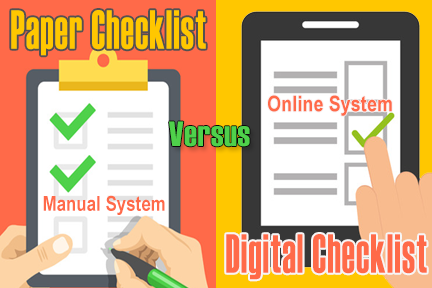 When to use paper checklists, versus digital checklists, depends on circumstances, and the people involved in a task.
When to use paper checklists, versus digital checklists, depends on circumstances, and the people involved in a task.
For example, when multiple people collaborate in processing a Job, Task, or Service, using one or multiple Quality Assurance Checklists and/or other documents, PAPER documents may be faster.
For the simple reason, everyone will see at-a-glance each other’s portion of the checklist. Especially, multiple quality checklists.
By contrast, if the same group uses one or multiple DIGITAL checklists, then observing each other’s portion of the checklist for compliance, may take longer.
Without a doubt, a DIGITAL document or checklist works better when ONE person uses it to complete a task; such as, on-boarding a new client’s information.
In this instance, recording and storing customer information digitally is IMPORTANT for future ease of retrieval. Not to mention, searching through metal filing cabinets for MANUAL documents is time consuming.
Companies Experience with Paper vs. Digital Documents
One company shared that they use PAPER documents, due to their less-than-clean production area and the fact that employees use gloves. In other words, it’s easier for them to fill out a paper form or checklist, manually, than to use an online digital document.
In fact, our formerly owned printing company used PAPER Quality Assurance Checklists. Because, by having a Job Ticket Folder traveling with the job through the production process, we found it more efficient for overseeing quality assurance.
In short, at each stage of production a completed Quality Assurance Paper Checklist was placed in the Job Ticket Folder. Our production employees liked the fact they could check each prompt on a paper checklist as they completed it. Because, it was faster than going to a computer or picking up a tablet.
Nevertheless, most documents in our Operations Manual were DIGITAL. For example, request for leave, corrective action, repair request, preventive maintenance, etc. Yes, we used both DIGITAL and PAPER.
Sadly, some companies’ shop employees are just not comfortable with digital technology, like computers. However, this may be due to age. A good place for retraining.
Other companies love digital checklists and documents; wanting to go totally paperless.
Don’t forget, digital online documents can be interactive, as well as static!
For this reason, we promote using a comprehensive, Business Process Management System, featuring a document system supporting both DIGITAL and/or PAPER.
The bottom-line for when to use Paper Checklists versus Digital Checklists is, it may require a little trial and error. In other words, experimenting with which works BEST. Best for your employees and your product or service!
There is no RIGHT or WRONG way to use documents. However, there is a BEST PRACTICE for every company!
A Well-known Hospital Uses Paper Checklists and Forms
A family member, we will call Mary, had shoulder surgery this past month at a well-known Tennessee hospital. In prepping Mary for surgery, each surgery team member entering her room opened Mary’s Patient Folder containing multiple PAPER forms and, particularly, QUALITY ASSURANCE CHECKLISTS, and began filling them out.
Importantly, each team member, i.e. an Anesthetist, would ask a series of questions, prompted by the checklist and then place an X by the correct answer, or write down Mary’s answer. Not surprisingly, these were all PAPER forms and checklists. Because, for their situation, PAPER worked more efficiently.
Furthermore, each team member would review other members’ portion of the checklist, and then proceed checking prompts that referenced their tasks. This happened over a course of two hours.
In fact, the hospital’s checklists prompted the placement of medical equipment, hypodermic shots, medicine and patient questions, etc. Very meticulous.
Finally, Mary’s surgeon came in, introduced himself, and opened Mary’s Patient Folder. He then asked prompted questions and filled out the checklists, along with other documents.
At one point, the checklist prompted the surgeon to write his INITIALS on Mary’s right shoulder, the very one needing surgery. However, BEFORE the surgeon wrote his initials on Mary’s shoulder, the checklist prompted him to ask Mary which shoulder was receiving surgery; AND, to describe the problem with that shoulder.
Unfortunately, before using checklist systems, medical history is rife with disastrous medical procedures performed on wrong limbs or using incomplete information.
Nothing left to chance at this Hospital!
For the record, this same hospital also uses DIGITAL checklists and forms for many other tasks, like new patient sign-in, or updating patients’ records.
Continuing with Mary’s prepping for surgery—the head nurse, aka team leader, came in, opened Mary’s Patient Folder, and reviewed EVERY checklist and document in the folder.
Surprisingly, while reviewing the SURGEON’S portion of a checklist, she turned and hurried out of the room. And, disappeared down the hall, leaving Mary’s Patient Folder open.
Within minutes, the surgeon, along with the head nurse, came back into Mary’s room. Whereas, the head nurse pointed to areas on the checklist the surgeon had FAILED to complete. At which point, the surgeon grabbed the special pen on the medical table and proceeded completing his omitted part of checklist.
Moreover, the surgeon re-signed the form and apologized to the head nurse for missing those steps. Whereby, she explained that they had recently added a few new prompts to the checklist.
In short, that is Continual Improvement in action.
Folks, as a Systems Analyst, it was a most fulfilling day observing QUALITY ASSURANCE practiced in our local hospital.
Did I mention? Great systems work… and can save lives!

Recent Comments